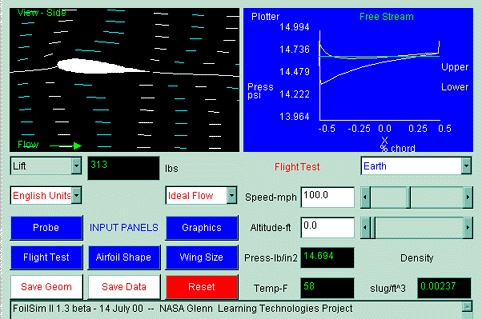
|
Wind
Gauges
Assessment of Knowledge
Gained Using
FoilSim Interactive Simulation Software
|

|
Subject Area: Physical Science and Mathematics
Grade Level: 8-10
National Mathematics and Science Standards:
- Mathematics:
- Use and value the connections between mathematics and other
disciplines.
- Unify concepts and processes through the production of
models and explanations.
- Science as Inquiry: Understandings about scientific
inquiry.
- Physical Science: Motions and forces.
- Science and Technology:
- Abilities of technological design.
- Understandings about science and technology.
National Technology Standards:
- Technology research tools: Use content-specific tools,
software and simulations (e.g., environmental probes, graphing
calculators, exploratory environments, Web tools) to support
learning and research; select and use appropriate tools and
technology resources to accomplish a variety of tasks and solve
problems.
- Problem-Solving and Decision-Making Tools - Routinely
and efficiently use on-line information resources to meet needs
for collaboration, research, publications, communications, and
productivity.
Objectives:
You will use FoilSim interactive software
to become familiar with the way in which the flow of air across or
around an airfoil affects its ability to create lift.
FoilSim is an interactive
simulation software package that examines the airflow around various shapes
of airfoils. As you change parameters such as airspeed, altitude, angle
of attack, thickness and curvature of the airfoil, and size of the wing
area, the software calculates the lift. The package was created at the NASA
Glenn Research Center.
FoilSim II is a Java applet program that executes inside the browser of your computer.
It is available on the World Wide Web at
http://www.grc.nasa.gov/WWW/K-12/airplane/foil2.html.
You can also
download the program to run off-line.
Shown below is a screen
shot from the program's controls and displays. You may change the values
of the variables by using the slider or the input box on the left of the
slider.
To use the slider:
- Click the mouse
pointer on the arrows at the ends of the slider.
- Click the mouse
pointer anywhere between the slider and the arrow.
- Drag the slider
with the mouse.
To use the input
box:
Simply select the
value in the input box, key in the new value, and press Enter or Tab when
finished. The button on the slider will move corresponding to the value
typed in the box.

To begin the problem, click on Wind
Gauge Activity.
Assessment:
You, or you and your partner(s), will be evaluated on the
ability of your wind gauge to determine the speed of the wind.
Evaluation:
You will be able to use FoilSim to complete the activity
and develop strategies that will solve the concept of wind speed.
The model should demonstrate a knowledge of the factors that
affect lift.
Submitted by: Lorri Turner, Monticello Middle School,
Cleveland Heights, Ohio.
|
